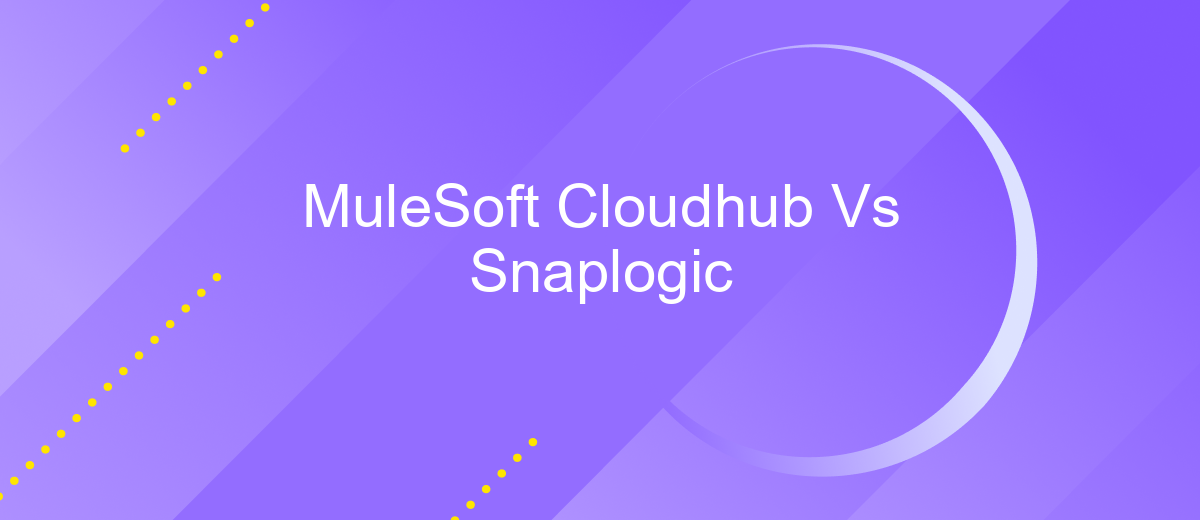MuleSoft Cloudhub Vs Snaplogic
In the rapidly evolving landscape of cloud integration platforms, MuleSoft CloudHub and SnapLogic stand out as leading solutions. This article delves into a comparative analysis of these two powerful tools, examining their features, performance, and suitability for various business needs. By understanding their strengths and limitations, organizations can make informed decisions to streamline their integration processes and enhance operational efficiency.
Introduction
In today's digital landscape, the ability to seamlessly integrate various applications and data sources is crucial for businesses. Two prominent platforms that facilitate this integration are MuleSoft Cloudhub and SnapLogic. Both offer robust tools for connecting disparate systems, but they cater to different needs and preferences.
- MuleSoft Cloudhub offers a comprehensive integration platform as a service (iPaaS) with a focus on API-led connectivity.
- SnapLogic provides an intuitive, scalable solution that emphasizes ease of use and rapid deployment.
- Both platforms aim to streamline workflows and improve operational efficiency.
Choosing between MuleSoft Cloudhub and SnapLogic depends on various factors, including specific business requirements, technical expertise, and budget constraints. Additionally, services like ApiX-Drive can further simplify the integration process by offering pre-built connectors and automation tools. This comparison aims to provide a detailed overview of each platform to help you make an informed decision.
Feature Comparison

MuleSoft Cloudhub and Snaplogic are both robust integration platforms, but they offer different features tailored to various needs. MuleSoft Cloudhub excels in providing a comprehensive API-led connectivity approach, enabling seamless integration of applications, data, and devices both on-premises and in the cloud. It offers extensive pre-built connectors and templates, making it easier for developers to speed up their integration projects. Additionally, Cloudhub's robust security features ensure data protection and compliance, which is crucial for enterprises handling sensitive information.
On the other hand, Snaplogic focuses on providing a user-friendly, visual interface that simplifies the integration process for both technical and non-technical users. Its AI-driven automation capabilities help in accelerating data integration workflows, making it a preferred choice for businesses looking for rapid deployment. Snaplogic also supports a wide range of data formats and protocols, offering flexibility in connecting diverse systems. For businesses seeking an easy-to-use solution with strong automation features, Snaplogic is a compelling option. For those who require a more API-centric approach, MuleSoft Cloudhub may be the better choice. Services like ApiX-Drive can further enhance these platforms by offering additional integration and automation capabilities, streamlining the process even more.
Use Cases

MuleSoft Cloudhub and Snaplogic are both robust integration platforms, each suited to different use cases. Understanding their strengths can help organizations choose the right tool for their specific needs.
- Data Integration: MuleSoft Cloudhub excels in complex, enterprise-level data integration tasks, while Snaplogic is ideal for quick and straightforward data integration projects.
- API Management: MuleSoft offers advanced API management capabilities, making it suitable for businesses that need to manage a large number of APIs. Snaplogic, on the other hand, provides basic API management functionalities.
- Cloud Integration: Both platforms support cloud integration, but MuleSoft Cloudhub is often preferred for hybrid cloud environments, whereas Snaplogic is more user-friendly for pure cloud integrations.
For businesses looking to streamline their integrations further, services like ApiX-Drive can be invaluable. ApiX-Drive offers a user-friendly interface and pre-built connectors, making it easier to set up and manage integrations without deep technical expertise. This can complement either MuleSoft Cloudhub or Snaplogic, depending on the specific integration needs.
Pricing

When comparing MuleSoft Cloudhub and Snaplogic, pricing is a crucial factor to consider. MuleSoft Cloudhub offers a subscription-based pricing model that varies depending on the number of cores and the level of support required. This can be a significant investment for enterprises looking for a robust integration platform.
Snaplogic, on the other hand, provides a more flexible pricing structure. It offers a tiered pricing model based on the number of pipelines and connectors used, making it an attractive option for businesses of all sizes. Snaplogic's pricing is generally considered more transparent and easier to scale according to business needs.
- MuleSoft Cloudhub: Subscription-based, core-dependent pricing
- Snaplogic: Tiered pricing based on pipelines and connectors
- Both platforms offer enterprise-level support and additional features at higher pricing tiers
For those looking to optimize their integration processes without a hefty upfront cost, services like ApiX-Drive can be a viable alternative. ApiX-Drive offers a cost-effective solution for setting up integrations quickly and efficiently, making it a practical choice for small to medium-sized businesses.
Conclusion
In conclusion, both MuleSoft Cloudhub and SnapLogic offer robust solutions for cloud-based integration, each with its unique strengths. MuleSoft Cloudhub excels in providing a comprehensive platform with extensive API management capabilities, making it ideal for enterprises that require advanced integration and connectivity. On the other hand, SnapLogic stands out for its user-friendly interface and rapid deployment, catering to businesses that prioritize speed and ease of use in their integration processes.
Choosing between these two platforms ultimately depends on your specific needs and priorities. For organizations seeking a balance between powerful features and ease of use, exploring additional tools like ApiX-Drive can be beneficial. ApiX-Drive offers a straightforward way to set up integrations without extensive coding, complementing the capabilities of both MuleSoft and SnapLogic. By carefully evaluating your integration requirements and considering supplementary tools, you can make an informed decision that aligns with your business goals.
- Automate the work of an online store or landing
- Empower through integration
- Don't spend money on programmers and integrators
- Save time by automating routine tasks
FAQ
What are the main differences between MuleSoft CloudHub and SnapLogic?
Which platform is better for real-time data integration?
How do the pricing models of MuleSoft CloudHub and SnapLogic compare?
What kind of support and community resources are available for MuleSoft CloudHub and SnapLogic?
Are there any alternatives to MuleSoft CloudHub and SnapLogic for implementing automation and integrations?
Time is the most valuable resource for business today. Almost half of it is wasted on routine tasks. Your employees are constantly forced to perform monotonous tasks that are difficult to classify as important and specialized. You can leave everything as it is by hiring additional employees, or you can automate most of the business processes using the ApiX-Drive online connector to get rid of unnecessary time and money expenses once and for all. The choice is yours!


